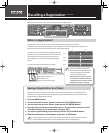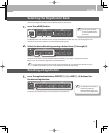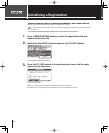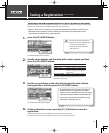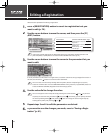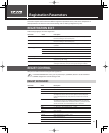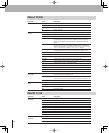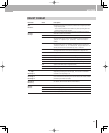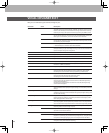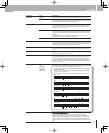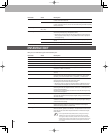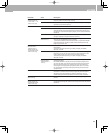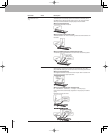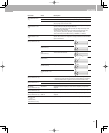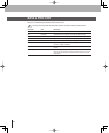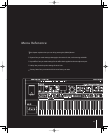
86
VOCAL DESIGNER EDIT
Here you can make settings
f
or the Vocal Designer part.
P
arameter Value Descri
p
tio
n
Input
S
ource Selects the modulator (p. 20)
.
T
he audio signal o
f
the part (AKEY, ENS, LOOPER) selected
f
or Input Source will
be sent to the modulator, and therefore will no longer sound in the usual way;
however
y
ou can pla
y
the Input Source directl
y
b
y
raising the [DIRECT] knob.
M
I
C
-EX
T
T
he audio signal from the mic jack will be used as the modulator. Normally,
y
ou can use this setting. B
y
turning on the rear panel [MIX TO MIC] switch, the
audio signal
f
rom the EXT IN
j
ack can also be used as the modulator
.
AKEY
T
he audio signal from Audio Key will be used as the modulator. For example,
this lets
y
ou use Audio Ke
y
to pla
y
back a wave
le containing a vocal, and use
t
h
at soun
d
to p
l
ay Voca
l
Designer
.
E
N
S
T
he audio signal
f
rom the Ensemble part will be used as the modulator.
Th
e Ensem
bl
e
p
art’s Am
b
ience Sen
d
wi
ll
b
e
d
isa
bl
e
d.
*
LOO
PER
T
he audio signal
f
rom the Sound Looper will be used as the modulator. For
e
xamp
l
e, t
h
is
l
ets you p
l
ay Voca
l
Designer using a voca
l
t
h
at was recor
d
e
d
into
the Sound Looper usin
g
direct microphone.
L
e
v
el
0
–127 Speci
es the volume o
f
the tone.
P
an
L6
4–
0
–
63
R Speci es the pan. “L64” is far left, “0” is center, and “63R” is far ri
g
ht
.
Dr
y
Sen
d
0–127 S
p
eci
es the volume o
f
the
p
art
.
A
m
b
i
e
n
ce
Se
n
d
0
–127 Speci es the level of the signal sent to the ambience
.
C
oarse Tun
e
-1
2
–+1
2
A
d
justs t
h
e pitc
h
up or
d
own in semitone steps (+/-1 octave).
F
i
n
e
T
u
n
e
-
50
–+
50
Ad
j
usts the pitch up or down in 1-cent steps (+/-50 cents)
.
One cent is 1
/
100th of a semitone.
Octa
v
e
-
3
–+
3
Ad
j
usts the pitch o
f
the sound up or down in units o
f
an octave (+/-3 octaves)
.
T
one -64–+6
3
A
d
justs t
h
e tone.
Increasing the value will strengthen the highs, producing a clearer sound
.
Decreasing t
h
e va
l
ue wi
ll
restrain t
h
e
h
ig
h
s, pro
d
ucing a mi
ld
er soun
d.
Attac
k -
6
4–+
63
Ad
j
usts the attack.
Increasing t
h
e va
l
ue wi
ll
ma
k
e t
h
e attac
k
more gent
l
e.
Decreasin
g
the value will make the attack sharper.
Re
l
eas
e
-64–+6
3
A
dj
usts t
h
e re
l
ease
.
Increasing the value will lengthen the time from note-o (releasing the key)
unti
l
t
h
e soun
d
d
isappears
.
Decreasing the value will shorten the time from note-o (releasing the key)
until the sound disappears
.
V
i
b
rato Rate -64–+6
3
A
d
just t
h
e vi
b
rato spee
d
(t
h
e rate at w
h
ic
h
t
h
e soun
d
is mo
d
u
l
ate
d
). T
h
e soun
d
will be modulated more rapidl
y
f
or higher settings, and more slowl
y
with lower
sett
i
ngs.
V
ibrato Dept
h
-
6
4–+
63
Adjusts the depth o
f
the vibrato e
ect (the depth at which the sound is
modulated). The sound will be modulated more greatl
y
f
or higher settings, and
less with lower settin
g
s.
V
i
b
rato De
l
a
y
-64–+6
3
Adjusts the time dela
y
until the vibrato (sound modulation) e
ect begins.
Higher settings will produce a longer delay time before vibrato begins, while
l
ower settings pro
d
uce a s
h
orter time.
Bend Ran
ge
0
–1
2
Speci es the de
g
ree of pitch chan
g
e in semitones when the Pitch Bend lever is
all the wa
y
right/le
f
t. For example, i
f
this parameter is set to “12,” the pitch will
rise one octave w
h
en t
h
e pitc
h
b
en
d
l
ever is move
d
to t
h
e ri
gh
t-most position
.
Bend T
y
p
e
NO
RMAL
T
he pitch bend lever will operate in the conventional wa
y
(movement o
f
the
l
ever wi
ll
pro
d
uce smoot
h
c
h
an
g
es in pitc
h
).
C
HR
O
MATI
C
T
he pitch bend lever will change the pitch in semitone steps, simulating the
sound of vocal correction software.
B
e
n
d
M
ode
NO
RMAL
T
he pitch bend lever will operate in the conventional wa
y
.
LOC
K1 In this mode, pitch bend will not be applied to a new note that is played while
the pitch o
f
a previousl
y
pla
y
ed note is alread
y
being bent. B
y
using this setting
i
n conjunction with playing legato, you can create portamento-like e ects
.
LOC
K
2
Operation is essentiall
y
the same as LOCK1, but there will be no pitch change
i
n response to t
h
e pitc
h
b
en
d
l
ever returnin
g
.



